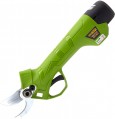Battery voltage
The operating voltage of the battery installed in the tool of the corresponding type (see above).
The higher the power, the higher the voltage may be required (but not necessarily required) to power it efficiently. In other words, a high battery voltage is usually indicative of advanced performance, while a low battery voltage is not always a sign of an entry-level tool. On the practical side, this parameter can only be useful for some specific tasks — for example, looking for an external charger for a battery or buying a spare battery. In addition, this parameter must be taken into account when comparing different batteries in terms of capacity (for more details, see "Battery Capacity").
Handle material
—
Plastic. Relatively simple and at the same time quite practical, as a result — a common material. Plastic perfectly resists moisture, almost does not cool hands in cool weather, and is relatively inexpensive. As for strength and reliability, they are generally somewhat lower than those of metals, and most tools with plastic handles are designed mainly for simple work with relatively low loads. However, there are exceptions — for example, powerful loppers, which use high-quality durable plastic grades for handles. Anyway, for additional convenience, handles made of this material are often supplemented with rubber pads.
—
Steel. The key advantage of steel is its high strength, which makes it possible to use this material even in the most powerful tools designed for thick branches. Compared to another metal — aluminium — steel weighs a little more, but costs less. For additional resistance to corrosion and ease of holding, steel handles can be coated with paint or equipped with additional overlays, most often of rubber or plastic.
—
Aluminium. Another metal used for handles is along with steel. Aluminium differs from it, on the one hand, in lower weight and better resistance to corrosion, on the other hand, in higher cost. However, the difference in price is not so great, so these handles are also very popular. They can also be equipped with various overlay
...s for added convenience.
— Tree. "Classic of the genre", not out of use today. The wood is pleasant to the touch, does not cool hands in cool weather and looks good. In terms of reliability, this material is comparable to plastic: it is inferior to steel and aluminium, but it is quite applicable even in fairly powerful tools. The unequivocal disadvantages of wood include poor resistance to scratches and chips. Because of this, accidental contact with sharp objects can lead to the appearance of chips, fraught with splinters. In addition, this material does not tolerate constant contact with moisture, and it is advisable to store a tool with wooden handles in a dry place. Note that for a number of reasons, the tree is used mainly in one-handed tools.Handle material
The material from which the additional overlays for the tool handle are made. Most often, this material differs from the material of the handle itself (see above), but there are exceptions — for example, additional plastic lining on the plastic handle. Anyway, the most popular types of materials are as follows:
— Rubber. Convenient, practical and inexpensive, and therefore — an extremely popular material. Secure to hold and at the same time relatively soft, making it great for both plastic and metal handles: rubber grips do not slip in the hand, do not cool the skin in cool weather and provide additional comfort due to the softness. The disadvantages of rubber include poor scratch resistance and a slightly higher cost than another popular option — plastic. However, in general, these shortcomings cannot be called critical.
— Plastic. Another fairly popular material, widely used primarily with steel and aluminium handles. Plastic provides a secure hold, it does not slip in the hand like metal; in addition, such pads are not afraid of moisture and can also play the role of additional protection against corrosion. However plastic is harder than rubber and somewhat less reliable and durable; On the other hand, it also costs much less.
— Wood. A material rarely used, mainly with metal (steel) handles. The tree is very attractive in terms of convenience: it is pleasant to the touch, does not cool the hands and almost does not slip. On the other hand, su...ch pads are less reliable than rubber or plastic ones, they do not tolerate moisture (the material can swell and warp) and contact with sharp objects (slivers can form, threatening splinters). So it makes sense to specifically look for wooden handles, first of all, if you are a principled adherent of the classics.
— Cork. The cork does not slip in the hands and perfectly absorbs moisture, thanks to which it is securely held in the hands. In addition, this material is soft and elastic, which gives additional convenience and comfort. At the same time, compared to the same rubber, cork is less durable: it is relatively easily damaged and, without special care, quickly absorbs dirt, which can cause it to lose its “presentation” and then its working properties. As a result, cork overlays are extremely rare — in some models of garden tools.
Storage case
A
case is included with the instrument. Such cases can be made of both soft and hard materials; the former are more compact, the latter more reliable. Anyway, such an accessory provides additional convenience during storage and transportation: it protects the tool from dirt, moisture and other adverse factors, and the surrounding objects from accidental contact with the blades. Impromptu packaging can also be used for the same purpose, however, complete cases, usually, are much more convenient.

